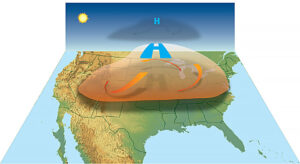Recently, many people saw a series of lights traveling across the early morning sky. That string of celestial pearls was the 23rd launch of a cluster of Starlink satellites.
Starlink is a satellite-based internet service that is the brainchild of Elon Musk, the founder of Tesla motors and of SpaceX, a private space flight company.
The network, or “constellation,” of satellites will consist of thousands of mass-produced small satellites in low Earth orbit (LEO), working in combination with ground transceivers. SpaceX plans to sell some of the satellites for military, scientific, or exploratory purposes. The SpaceX satellite development facility in Redmond, Washington houses the Starlink research, development, manufacturing, and orbit control.
The development of that network began in 2015. SpaceX trademarked the name Starlink for its satellite broadband network in 2017. The name was inspired by the book The Fault in Our Stars. SpaceX launched its first two Starlink test crafts, named TinTinA and TinTinB, in 2018. The mission went as planned. Based on initial data, the company asked communication regulators for its fleet to be allowed to operate at lower altitudes than originally planned, and the FCC agreed.
SpaceX’s plans in 2019 were for the initial 12,000 satellites to orbit in three orbital shells: First shell: 1,440 in a 550 km (340 mi) altitude shell, second shell: 2,825 Ku-band and Ka-band spectrum satellites at 1,110 km (690 mi), and third shell: 7,500 V-band satellites at 340 km (210 mi).
The first 60 Starlink satellites were launched on May 23, 2019, aboard a SpaceX Falcon 9 rocket. The satellites successfully reached their operational altitude of 340 miles (550 kilometers) which is low enough that once they cease to operate, they will be pulled down to Earth by atmospheric drag in a few years, so that they don’t become space debris, posing a hazard to operational satellites.
So far, SpaceX has launched over 1,300 satellites, the most recent launch being the 23rd, on April 7, 2021. The company has approval for over 12,000 satellites, and sources say SpaceX may want as many as 42,000. This was the seventh launch and landing on the reusable Falcon 9 first stage booster, which previously launched NASA astronauts Bob Behnken and Doug Hurley to the International Space Station.
According to Sky & Telescope magazine, each Starlink satellite weighs 500 lbs. (227 kilograms) and is approximately the size of a table.
Current satellite internet utilizes large spacecraft that orbit 22,236 miles (35,786 km) above a particular spot on the Earth (geosynchronous orbit). But at that distance, there are generally significant time delays (latency) in sending and receiving data. By being closer to the Earth and networking together, Starlink’s satellites are meant to carry vast amounts of data swiftly to any point on the planet.
Though fiber-optic cable offers upload and download speeds that are significantly faster than satellites’, it is highly likely that internet services like Starlink will reach the majority of underserved communities long before fiber ever will. It appears from recent FCC filings that Starlink may also provide dedicated phone service.
“Starlink is now delivering initial beta service both domestically and internationally and will continue expansion to near-global coverage of the populated world in 2021.
During beta, users can expect to see data speeds vary from 50Mb/s to 150Mb/s and latency from 20ms to 40ms in most locations over the next several months as we enhance the Starlink system. There will also be brief periods of no connectivity at all.
As we launch more satellites, install more ground stations, and improve our networking software, data speed, latency, and uptime will improve dramatically.”
Musk tweeted in February that he expects the service to double its top download speed to 300Mbps by the end of 2021.
Astronomers are worried about unforeseen consequences for stargazing and for the protection of nocturnal wildlife. To assuage those concerns, Starlink has begun testing a variety of new designs intended to reduce the brightness and visibility of its satellites. At the start of 2020, the company tested a “DarkSat” satellite that has a special, non-reflective coating. In June of 2020, the company launched a “VisorSat” satellite that features a special sunshade visor. In August, Starlink launched another batch of satellites that were all equipped with visors.
Another concern is collisions with existing orbiting craft. SpaceX has stated that it will collaborate with organizations and space agencies to alleviate the impacts of its mega constellation.
For more information about Starlink, go to starlink.com.










